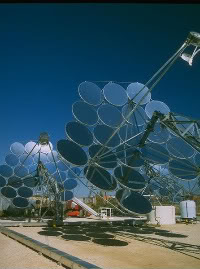Cancer Rates and Fossil Fuels

CO2 is a problem and a huge one, but it doesn’t compare with chemical pollution. From 1973 to 1999 childhood cancers increased 26 percent. Acute childhood lymphcytic cancer is up 61 percent, brain cancer up 50 percent and bone cancer is up 39 percent. this does not include the problems caused by the chemicals leaching into food and water from containers causing dramatically reduced numbers of male babies along with reproductive issues.
Chip: Thanks very much for this. I’m reminded of some of my previous posts on the externalities associated with fossil fuels and how to quantify them. Ironically, it’s far easier to find numbers for the things that carry nowhere near the level of tragic impact as the things you’re talking about here. For example, we add up the cost of treating a case of lung cancer, but ignore the suffering of the victim and his family.
I believe that in 50 years the energy companies will be subjected to the aggression that the tobacco industry is receiving today in terms of class-action lawsuits and broad societal condemnation. We see it starting already, with pieces like 60 Minutes treatment of coal ash a couple of months ago. (This was the quintissential 60 Minutes hatchet job — but it’s a good sample of the scorn that’s coming down the pike — both fair and unfair.)
I point out to Chevron and its shareholders that the average wrongful death award in the US is in measured in seven figures; that adds up fast, people.
People talk about the high cost of PV, wind, geothermal, etc. But that’s only because most of the true cost of coal and oil is passed along to the family of some anonymous eight-year old kid slowly dying in a hospital bed. Given any even remotely fair-minded treatment of renewables, clean energy is the bargain of the century.
Thanks again for writing.



 A reader points out:
A reader points out:
 I posted this
I posted this 

 I asked global warming (GW) skeptic Jarrett Buys to explain the melting of the glaciers as evidenced by photos taken over the last century and the data
I asked global warming (GW) skeptic Jarrett Buys to explain the melting of the glaciers as evidenced by photos taken over the last century and the data
 “The good news is, you got an order from Costco,” my good friend John Tyson says, explaining the discussions he has with his clients. “The bad news is, you got an order from Costco.” He then elucidates, laying out the great many things that could qualify as “bad news” about receiving an order for millions of dollars worth of whatever it is the client happens to be selling: brutal negotiations, ridiculous delivery schedules, oppressive logistics, and, at the end of it all, the threat that, if you’re one iota off in any way, you’ll never get another chance.
“The good news is, you got an order from Costco,” my good friend John Tyson says, explaining the discussions he has with his clients. “The bad news is, you got an order from Costco.” He then elucidates, laying out the great many things that could qualify as “bad news” about receiving an order for millions of dollars worth of whatever it is the client happens to be selling: brutal negotiations, ridiculous delivery schedules, oppressive logistics, and, at the end of it all, the threat that, if you’re one iota off in any way, you’ll never get another chance. 
 I have to admit that I find myself in a quandary about products that are not strictly speaking environmentally sustainable but that offer considerable benefits compared to those that they would replace. Obviously, the world would be a cleaner place if we’d stop burning hydrocarbons, but the truth is we can’t – or we won’t – and thus it makes sense to understand the nature of certain compromises that are available.
I have to admit that I find myself in a quandary about products that are not strictly speaking environmentally sustainable but that offer considerable benefits compared to those that they would replace. Obviously, the world would be a cleaner place if we’d stop burning hydrocarbons, but the truth is we can’t – or we won’t – and thus it makes sense to understand the nature of certain compromises that are available.
 I conducted my interview with ex-CIA director
I conducted my interview with ex-CIA director 
 Merry Christmas everyone!
Merry Christmas everyone!
 The only downside I see to spending a few minutes of my life every day writing a new blog post is the concern I have for “preaching to the choir.” With few exceptions, it seems to me that the people at 2GreenEnergy,
The only downside I see to spending a few minutes of my life every day writing a new blog post is the concern I have for “preaching to the choir.” With few exceptions, it seems to me that the people at 2GreenEnergy,